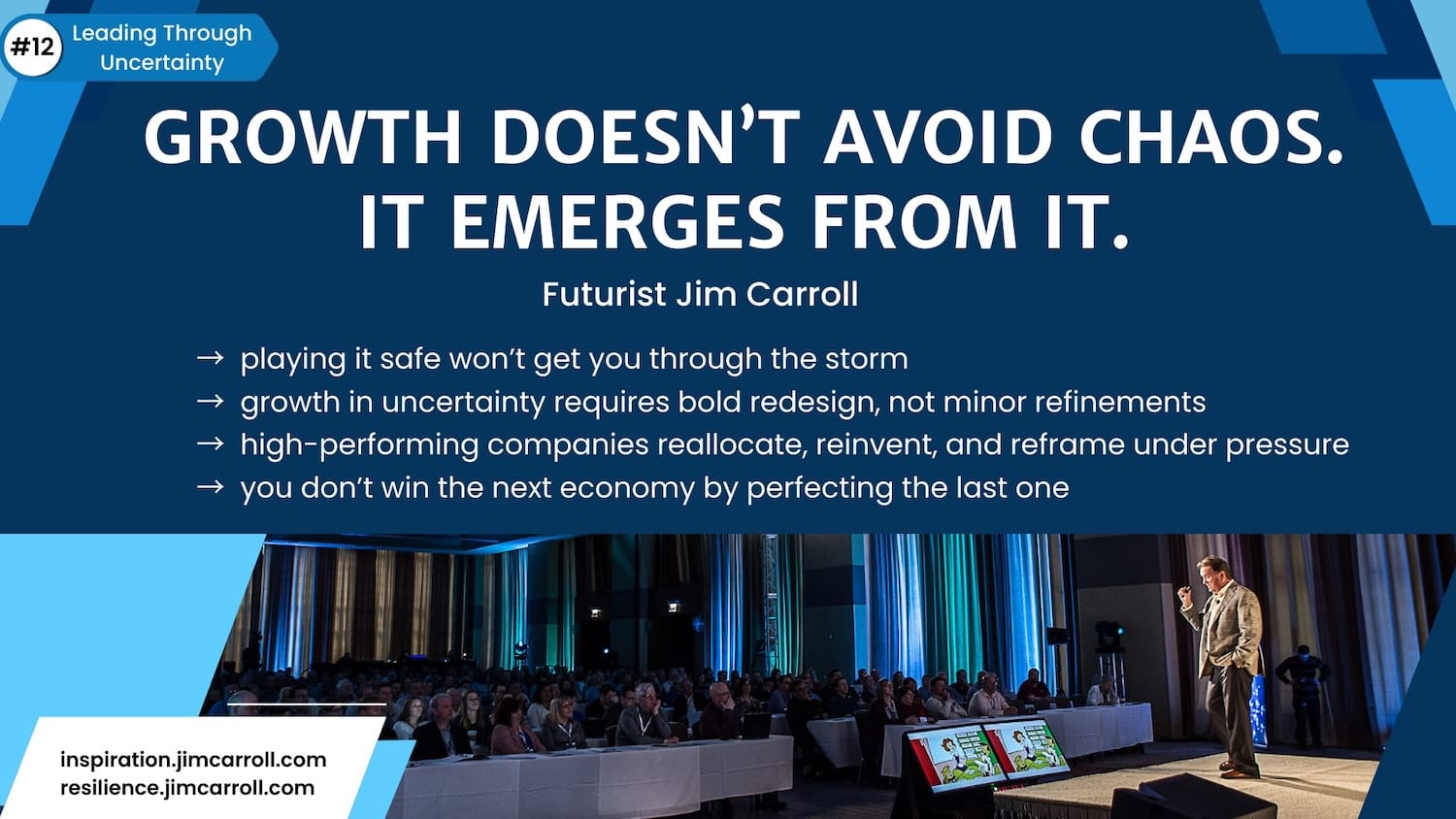"Growth doesn't avoid chaos. It emerges from it." - Futurist Jim Carroll

You don’t rebuild for the future by protecting the past - particularly during a downturn.
So let's recap. In the first ten posts of this series, I've covered how belief, vision, action, and momentum create forward motion, even amid chaos. And yesterday, I pulled back the curtain on why many organizations fail to make that motion: fear, inertia, denial, and outdated thinking. You know, organizational sclerosis stuff!
Now we turn a corner.
Because once you’ve cleared the internal barriers…once you’ve named what’s been slowing you down… the next step is this: growth. And growth doesn’t come from optimizing what used to work. It comes from disrupting it. As they say, if you keep doing what you've always done, you'll get what you've always got! This will become exacerbated even more in the wild year that is 2025.
Fact is, In a downturn, many companies fall into a dangerous trap: they tweak the old playbook, hoping that what worked before will work again. So they shave budgets instead of rewriting business models. They cut costs without realigning purpose. They focus on “efficiency” instead of rethinking how they create value. They keep trying to sell the old product or service when the market suddenly needs a new one.
That’s not a strategy. That’s maintenance. And it fails every time
The companies that grow during volatility? They do the opposite. They redesign, not refine. They reinvent, not recover. They know that you won’t win in the next economy by trying to redo the last economy better. Here’s how high-performing, future-ready companies build through disruption—not despite it:
- they create new value, not just cut costs
- they launch new offerings that solve urgent problems in emerging markets or underserved segments.
- they reallocate skills and teams aggressively to solve problems, fast
- they implement a strategy of focusing on core customers to defend key revenue
Talent, capital, and attention all shift. They move decisively away from underperforming bets and double down on future-ready opportunities. They break their assumptions. They don’t ask how to make something slightly better. They ask what it would look like if they had to build it from scratch for today. They eliminate internal friction. Bureaucracy, bloated processes, and clunky systems are removed. They rebuild for speed and simplicity. They accelerate decisions with small, empowered teams that test, launch, and adapt.
They don’t wait for perfect clarity—they create clarity through motion.
If you want to grow through uncertainty, you need more than vision—you need action. Growth in a downturn doesn’t come from fine-tuning the past. It comes from designing for what’s next.
The companies that do that don’t just recover. They redefine their markets.
A Lesson from 2009: What Growth-Minded Companies Did
Back in the wake of the 2008 economic collapse, I noticed a feature by BusinessWeek called “10 Worst Innovation Mistakes in a Recession,” I believed the more important question was this: What should you do instead?
So I wrote this post below in 2009, capturing real-world strategies I had seen in action across industries.
Everything below still applies today—perhaps even more than it did then.
10 Things You Need to Do to Innovate in a Recession
April 28, 2009
Business Week ran an article in January, "10 Worst Innovation Mistakes in a Recession."
It's easy to point out mistakes. It can be harder to indicate what you should be doing.
I've been speaking to organizations about trends, the future, innovation, and creativity for fifteen years. Since last year, when the meltdown began, I've been keynoting events worldwide, rapidly adjusting my theme to one of "how you can innovate during a recession." I've had the opportunity to see firsthand quite a few very innovative strategies from CEOs and others in a wide variety of events, and I keep modifying my message at a rapid speed to incorporate a vast variety of ideas.
So I just took a few minutes to post a comment to the Business Week site, and I'll post my quick thoughts here too.
Here's a list of 10 off the top of my head:
1. Focus your team—relentlessly—on growth. I keynoted a global organization in Las Vegas in February. The CEO got on stage before me and spoke about the recession for one minute. He then spent 19 minutes outlining the growth opportunities the organization could pursue. That’s the mindset we need.
2. Respond faster. At a food industry summit in New York, we spoke about how consumer preferences were shifting rapidly—more people eating at home, watching spending, and seeking comfort. Reformulate products and launch fast. Don't study. Do.
3. Invest in the brand. Brands can weaken in a recession. Now is the time to reposition or reinforce, not pause.
4. Mix it up. What worked before may not work now. Experiment with product mix, price points, and messaging.
5. Invest in experience. When staff are down and spinning their wheels, focus them. Build team resilience through experimentation and action.
6. Kill off the innovation killers. Paranoia kills creativity. Create a culture where “What a great idea” is the reflex, not “what could go wrong?”
7. Collaborate within the industry. I saw incredible peer-sharing during a keynote for the American Nursery and Landscape Association. Ideas were flying. Everyone benefited.
8. Seek ideas. Go knowledge farming. Great ideas for processes, products, or services are everywhere—go find them and apply them.
9. Partner up. Innovation accelerates with help. Partnerships in operations, technology, or delivery can bring growth faster than going alone.
10. Get over it. Too many teams stay stuck in grief over what was lost. Acceptance clears the path for forward motion.
Why does this advice from 2009 still matter in 2025? Because EVERYTHING on that list is still relevant. Still effective. Still ignored by too many.
Growth in a downturn is not an accident. It’s a choice—and a commitment. The companies that succeed don’t overanalyze the chaos. They don’t cling to legacy plans.
They act. They move. They build. They experiment. They disrupt.
And because of that, they don’t just survive the storm.
They shape what comes next.
They grow.
Futurist Jim Carroll knows that right now, a lot of people are losing site of long-term trends — which is exactly the wrong thing to do.

